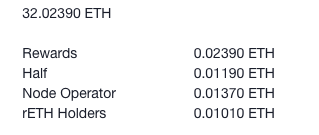Context: current state of skipping
Right now, NOs can skip the queue by providing 32 ETH, and having the 16 ETH refunded later (after there are no minipools waiting for 16 ETH matching). A challenge is that this is most interesting to NOs when the deposit pool is low compared to the minipool queue – this implies that they may have a long wait time for their refund, which is (obviously) very capital inefficient.
The main suggestion is to allow users to provide 32 ETH, and get rETH for the ETH beyond their share of the minipool.
Flow:
- User provides 16 ETH for their minipool and begins waiting for 16 ETH to get paired from the deposit pool.
- If waiting for community ETH (from 1), user can choose to skip this queue by lending 16 ETH to the minipool.
a. These 16 ETH will be refunded automatically once there is no minipool queue and enough ETH in the deposit pool. - If waiting for an ETH refund (from 2), user can opt to receive (
16*mint_ratio) rETH immediately to their withdrawal address instead of getting a later refund.
How is each stakeholder affected?
TL; DR: good for NOs, unclear for rETH holders, good for protocol TVL
Detailed stakeholder breakdown
New NOs:
- Gain the option to instantly skip minipool queue at any time during wait, not just during initial setup. Since this is optional, this is a strict win.
- Gain the option to instantly skip the refund queue if they wish (by getting rETH). Note this may be a taxable event depending on jurisdiction. Since this is optional, this is a strict win.
- 16 ETH depositors are benefited by smaller queues. Since this only creates additional opportunities to skip the queue, this is a strict win.
- I should note that, outside of the taxable event issue, it’s nearly always worth it to the NO to take the rETH. Why? If they’re willing to wait until the deposit pool is non-empty, that’s the similar to saying they’re willing to wait till rETH is valued at least as high on the market as when directly burned. This means they’re getting a full refund, at roughly the same time, with the benefit of having APR in the meantime.
- Potential indirect benefit to RPL value via increased number of NOs (since some this decreases some perceived startup cost).
rETH holders:
- 32 ETH depositors currently help rETH holders a good bit until their refund. They provide the protocol with the output of 32 ETH, but only take the standard rewards. This means rETH holders are getting rewards_per_ETH*.85*16 for free!
- Insofar as there are more 32 ETH depositors (take step 2 after setup), this increases APR
- Insofar as there are fewer 32 ETH depositors (take step 3, when they’d otherwise have chosen to be a 32 ETH depositor at setup and waited for a refund), this decreases APR
- Potential indirect benefit to rETH utility via protocol health – healthier/larger protocols are more likely to be used in defi.
Protocol health:
Here I assume (A) greater TVL is good and (B) the deposit pool is empty with a minipool queue. When (B) isn’t true, this whole proposal is irrelevant as there will be no need to skip empty queues.
- (B) implies there is less demand for rETH at the mint rate than supply at that rate. In other words, the market rate is lower than the mint rate.
- This proposal incentivizes locking additional value into the protocol. NOs will want to mint rETH at the mint rate, even though it’s above market, because that allows them to start earning APR sooner. In short, we’re allowing an efficient market where NOs can choose to pay an upfront fee (by minting below market) to get extra time with active rewards.
- What does the NO do with the rETH?
- Sells and doesn’t do anything else RP-related. In this case, this will marginally decrease the market value of rETH.
- Slightly negative for TVL vs being a 16 ETH depositor.
- Holds until the deposit pool is non-empty (aka the market rate and the mint rate converge). In this case, this is very similar to a refund with the major difference being that the NO got the benefit of their 16 ETH instead of that benefit being spread across all rETH holders.
- Significantly positive for TVL vs being a 16 ETH depositor.
- Neutral for TVL vs being a 32 ETH depositor.
- Sells to buy RPL. Marginally decreases the market value of rETH, but marginally increases the market value of RPL.
- Significantly positive for TVL vs being a 16 ETH depositor.
- ~Neutral for TVL vs being a 32 ETH depositor.
- Sells to start another minipool. Marginally decreases the value of rETH, but locks the whole value back into RP.
- Significantly positive for TVL vs being a 16 ETH depositor.
- Slightly negative for TVL vs being a 32 ETH depositor.
- Sells and doesn’t do anything else RP-related. In this case, this will marginally decrease the market value of rETH.
